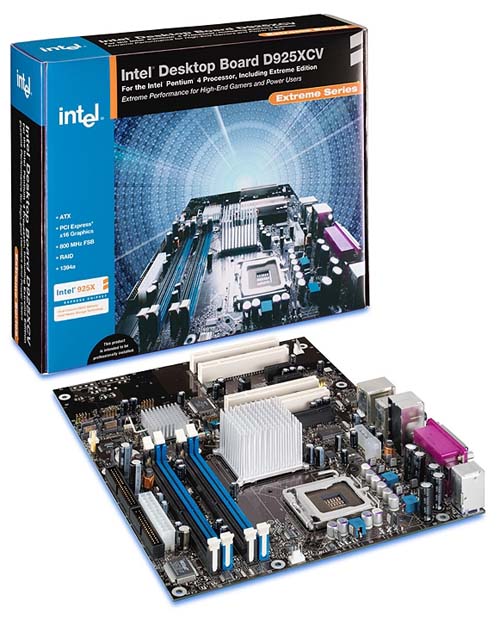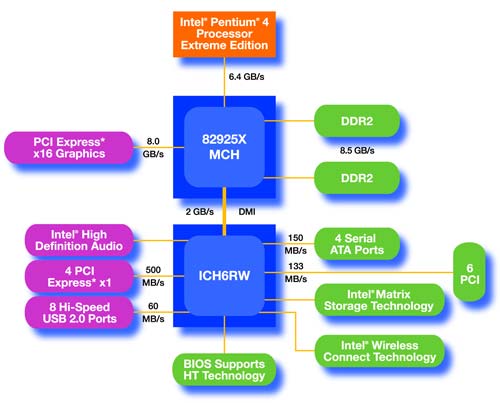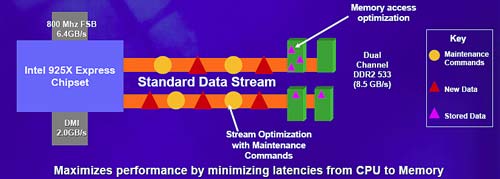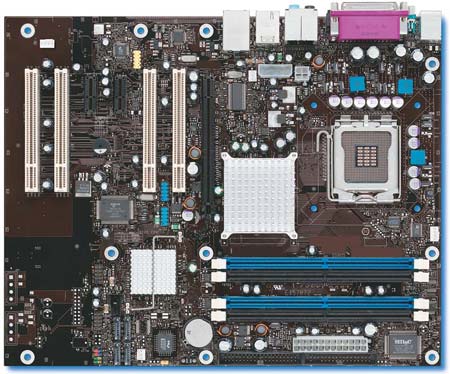Intel 925X/915: Chipset Performance & DDR2
by Wesley Fink on June 19, 2004 3:01 AM EST- Posted in
- CPUs
Intel 925X Express
The Intel D925XCV is the Enthusiast version flagship for all the new Intel technology.
That is not to say Enthusiasts will stand in line to buy the new Intel board, since Intel has not traditionally supported the kinds of features and adjustments that will sway enthusiasts to buy a high-end Intel motherboard. The top Intel motherboard is always, however, a top-performing motherboard at default speeds, and it becomes the chipset performance standard. It is also the standard-bearer for Intel chipset features.
If you look carefully, you will see that the power connectors on the new motherboards, both 925X and 915, are 24-pin, and not the common 20-pin ATX connectors on current Pentium 4 power supplies. We found that server grade power supplies providing 24-pin connectors work fine on the new boards. However, if you have a new top-line PCIe graphics card you will likely find a new 6-pin power connector on the graphics card. You will need either a new power supply with the 6-pin graphics connector or a converter cable that allows two 4-pin molex to be combined in a 6-pin connector to power the new high-end PCIe cards. This is true of both 925X and 915 boards.

925X only supports DDR2 and PCI Express 16X graphics. 925X is also the only 775 chipset version that is stated to support ECC memory. We were not able to verify ECC support, since we did not have access to DDR2 ECC memory. The other features are related to the ICH6 version used with 925X, though you will more likely see ICH6R and ICH6RW (pictured here) paired with 925X.
The other distinguishing feature of Intel 925X is accelerated performance modes compared to 915 chipsets. Intel first differentiated their "Enthusiast" board with enhanced performance on the 875 chipset. The 875 chipset featured PAT, or Performance Acceleration Technology, which was supposed to be a unique feature of the 875 chipset. Chipset manufacturers began revising 865 boards to support PAT-like performance almost as soon as Intel launched 865/875. This was not a development that pleased Intel.

This time around, Intel is also differentiating their top chipset with enhanced performance. Intel did not share any catchy names like PAT, and the diagram above is the only information that they provided on how they make the 925X faster. When we asked for more information than the almost meaningless diagram above, Intel said their acceleration methods were "proprietary". This is not really a surprise after the PAT confusion with 875/865. Industry sources tell us that the new acceleration scheme used on 925X is much more complicated than PAT; it will not likely appear on 915 chipset solutions from other manufacturers.











57 Comments
View All Comments
nserra - Tuesday, June 22, 2004 - link
You guys are only evaluating the performance, I think it's not that important, the features yes, those are important. The P4 is crap even with hyper-x,y,z, so it wasn't a "chipset" that was going to make a miracle.I would like to see the new platform tested, IGP, Sound system, EMT64 (is it enable on LGA775 processors?), NX bit?, new power saving techniques, so new features up to test.
At least the DDR vs DDR2 comparison is a good thing.
I was hopping that DD2 would give a performance boast, since the P4 architecture relies on higher bandwidth and higher latency (the pros of RDRAM i850), but I guess not....
Bozo Galora - Monday, June 21, 2004 - link
yes he's sureRyanVM - Monday, June 21, 2004 - link
#54, Are you sure you aren't thinking of the S754/S939 dual socket mobo?tfranzese - Sunday, June 20, 2004 - link
#53, yes, there's a board that was shown at Computex that had both sockets giving the option to use one or the other.RyanVM - Sunday, June 20, 2004 - link
So, any chance that the 915 chipset can be tied to a socket 478 + Northwood? :DMarlin1975 - Sunday, June 20, 2004 - link
AMD does not really need dual ch. memory. Look at the diff. between a socket 939 and 754, it is very little for most apps. Also Dual Ch memory is not new. It was used WAY back in the day.The only reason it is back is because intel can't design a decent CPU so they have to make up for it with pricey and unneeded tech.
tfranzese - Sunday, June 20, 2004 - link
Anemone, there's really little reason you need dual-channel memory on the AMD64 platform with the memory controller being on the chip.Anemone - Sunday, June 20, 2004 - link
Anti overclocking designs in the new chipsets? Very poor choice.I will reiterate Intel performance per $ over its previous generations is pathetic. More $ required per degree of performance and the increase over last year is poor.
AMD is expensive until you get to the 754 - but perhaps I'm mistaken but I thought the industry had left single channel memory configurations behind 2 years ago. Oh wait, it's AMD, that's about their catchup period, sorry. So yes look at AMD in dual channel AMD64 chips and yes they are very pricey. So much for their argument that by providing competition they keep prices down.
Add to all that the overclocking unfriendly stuff, and while AMD comes out as better overall, the performance per $ is still not markedly better than last year, imo.
:)
Bozo Galora - Sunday, June 20, 2004 - link
"My My We are in trouble now arent we..."Yeah, I guess we might have to offer AMD a few of our (cash in the bank) billions to buy them out. I wonder if the FTC will allow that? Hmmmmm. Let's investigate.
firtol88 - Saturday, June 19, 2004 - link
My My we are in trouble now aren't we...Looks like AMD is the clear choice, unless you need a heater.